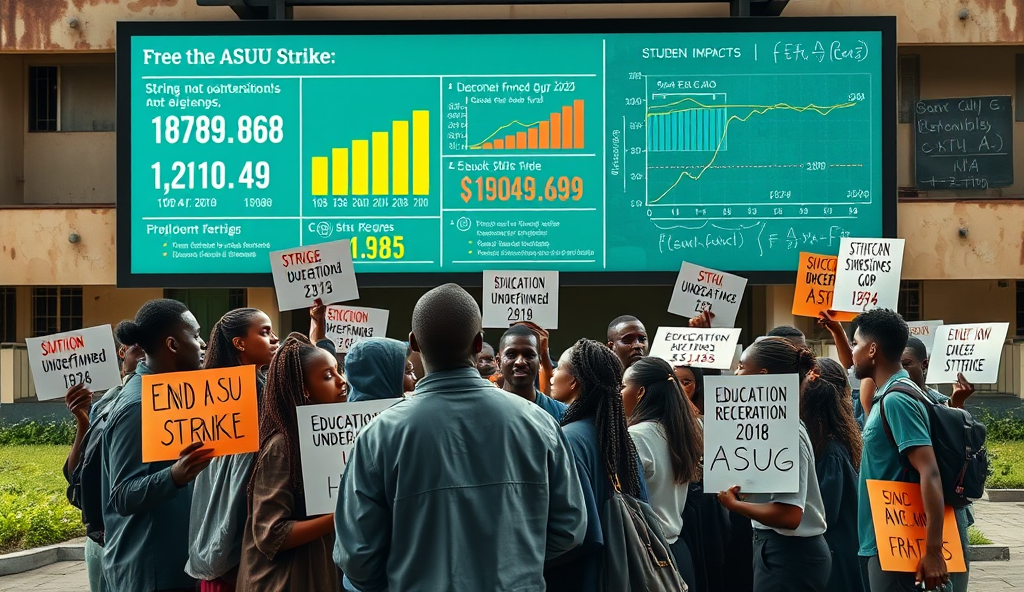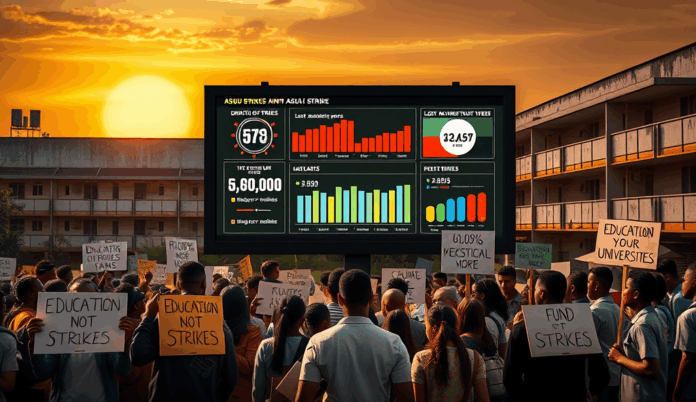Introduction to the ASUU Strike in Nigeria 2023
The 2023 ASUU strike marked another disruptive chapter in Nigeria’s higher education crisis, paralyzing academic activities across federal universities for months. This industrial action, declared by the Academic Staff Union of Universities, followed failed negotiations with the federal government over longstanding issues affecting the university system.
With over 1.5 million students affected nationwide, the strike disrupted academic calendars and delayed graduations, compounding frustrations from previous strikes. Key demands included improved funding for universities, better welfare packages for lecturers, and the implementation of previous agreements dating back to 2009.
As tensions escalated, students faced prolonged uncertainty about when the ASUU strike would end in Nigeria, sparking protests and calls for urgent resolution. The next section explores the root causes behind this industrial action and why negotiations repeatedly stalled between ASUU and the government.
Key Statistics

Causes of the ASUU Strike in 2023
The 2023 ASUU strike marked another disruptive chapter in Nigeria's higher education crisis paralyzing academic activities across federal universities for months.
The 2023 ASUU strike stemmed from unresolved disputes over the federal government’s failure to implement the 2009 FGN-ASUU agreement, particularly regarding university funding and lecturer welfare. Despite repeated negotiations, only 23% of the agreed ₦1.3 trillion revitalization fund had been released by 2023, leaving infrastructure in decay across 43 federal universities.
Another trigger was the contentious Integrated Payroll and Personnel Information System (IPPIS), which ASUU rejected over concerns about university autonomy and inconsistent salary payments. The government’s insistence on IPPIS despite ASUU’s alternative proposal (UTAS) created a stalemate, worsening trust deficits from previous strikes.
These systemic issues were compounded by delayed promotions, unpaid allowances, and rising inflation eroding lecturers’ purchasing power. As we’ll explore next, these unresolved conflicts had severe consequences for Nigerian university students caught in the crossfire.
Impact of the ASUU Strike on Nigerian University Students
Despite repeated negotiations only 23% of the agreed ₦1.3 trillion revitalization fund had been released by 2023 leaving infrastructure in decay across 43 federal universities.
The prolonged ASUU strike disrupted academic calendars for over 2 million students across Nigeria, with many institutions losing entire semesters and graduation timelines shifting by 12-18 months. Students faced financial strain from extended rent payments and forgone internship opportunities, compounded by inflation hitting 27.3% in 2023.
Psychosocial impacts emerged as depression rates among affected students rose by 40% according to NIMH surveys, while brain drain accelerated with 15,000 students seeking foreign admissions during the strike period. The decayed infrastructure highlighted in previous sections further worsened learning conditions upon resumption.
These disruptions set the stage for intensified government negotiations, which we’ll examine next as both parties faced mounting pressure from student protests and public outcry.
Government and ASUU Negotiations: Latest Updates
Students faced financial strain from extended rent payments and forgone internship opportunities compounded by inflation hitting 27.3% in 2023.
Amid mounting pressure from student protests and public outcry, the Nigerian government increased its offer to ASUU in Q4 2023, proposing a 23.5% salary increase for lecturers and ₦50 billion infrastructure revitalization fund. However, ASUU rejected these terms, insisting on full implementation of the 2009 agreement and proper funding for state universities, which currently receive only 8% of education budgets.
The negotiations reached a critical point when the government threatened “no work, no pay” enforcement, while ASUU cited the 27.3% inflation rate as justification for higher wages. Independent mediators from the Nigeria Labour Congress proposed a phased implementation plan, but both parties remain divided on timelines for fulfilling key demands.
With student unions planning nationwide demonstrations, these stalled negotiations set the stage for intensified protests, which we’ll explore in the next section. The deadlock continues to delay academic recovery for the 2 million affected students referenced earlier.
Student Protests and Reactions to the ASUU Strike
With over 15 months lost to strikes since 1999 the recurring standoffs highlight systemic funding and policy gaps in Nigeria’s education sector.
The National Association of Nigerian Students (NANS) mobilized over 50,000 students across 12 states in October 2023, demanding immediate resolution to the ASUU strike that had paralyzed academic activities for eight months. Protesters highlighted how the stalemate disproportionately affects final-year students, with 73% reporting delayed graduation plans in a NANS survey.
Students’ unions escalated tactics by occupying government offices in Abuja and Lagos, while social media campaigns like #EndASUUStrike trended for 11 consecutive days. These demonstrations forced the House of Representatives to convene an emergency session, though concrete resolutions remained elusive.
As frustration grows, student leaders warn of more disruptive actions unless both parties compromise, setting the stage for increased tension while alternative learning solutions gain traction among affected scholars.
Alternative Learning Solutions During the Strike
Student-led study groups leveraging WhatsApp and Telegram have also emerged with the University of Lagos recording over 150 peer-learning circles since the strike began.
With academic activities paralyzed, Nigerian students have turned to digital platforms like Udemy and Coursera, where enrollments surged by 42% among Nigerian users during the ASUU strike, according to a November 2023 EduTech Africa report. Student-led study groups leveraging WhatsApp and Telegram have also emerged, with the University of Lagos recording over 150 peer-learning circles since the strike began.
Some institutions like Covenant University have adopted hybrid learning, though this remains inaccessible to 68% of public university students due to infrastructure gaps highlighted in a NUC survey. Entrepreneurial students are converting the disruption into opportunities, with Lagos-based startup ScholarX reporting a 300% increase in users for its skill acquisition programs since July 2023.
As these stopgap measures proliferate, stakeholders question their long-term viability, shifting focus to government negotiations that could determine the strike’s resolution timeline. The effectiveness of these alternatives remains debated, even as pressure mounts for a permanent solution to the ASUU strike crisis.
Projected Timeline for Resolution of the ASUU Strike
Government sources suggest the ASUU strike in Nigeria could extend into early 2024, with negotiations stalled over unmet 2009 agreement demands, according to December 2023 Ministry of Education briefings. However, student unions project a faster resolution, citing mounting public pressure and the economic impact of prolonged academic disruptions on Nigeria’s education sector.
Historical patterns show most ASUU strikes last 3-9 months, but the current deadlock over funding allocations and salary structures complicates predictions. Education analysts note the government’s 2024 budget proposal, allocating only 8.2% to education versus UNESCO’s recommended 26%, signals potential delays in meeting union demands.
As uncertainty persists, students must monitor official channels for ASUU strike updates in Nigeria, with key developments expected during January’s National Assembly budget review sessions. The next section details reliable information sources to track negotiation progress and potential resumption dates.
How Students Can Stay Informed About the Strike
Given the uncertainty surrounding the ASUU strike in Nigeria, students should prioritize verified sources like ASUU’s official Twitter handle (@ASUUNGR) and the National Universities Commission (NUC) website for real-time updates. Local student union leaders also provide grassroots insights through WhatsApp groups and campus bulletins, particularly during critical periods like January’s National Assembly budget review.
For broader context, education-focused platforms such as EduCeleb.com and Premium Times’ education desk analyze negotiation trends, often referencing historical strike durations (3-9 months) and government budget allocations (8.2% in 2024). Radio programs like FRCN’s “Education Today” frequently host ASUU representatives and Ministry of Education officials for direct updates.
Students should cross-reference multiple sources to avoid misinformation, especially when rumors about potential resumption dates circulate. The next section will consolidate key takeaways and projections for the strike’s resolution, helping students plan their academic recovery strategies.
Conclusion and Final Thoughts on the ASUU Strike
The ASUU strike in Nigeria has left students grappling with uncertainty, disrupting academic calendars and career plans. With over 15 months lost to strikes since 1999, the recurring standoffs highlight systemic funding and policy gaps in Nigeria’s education sector.
Recent negotiations between ASUU and the Nigerian government show minimal progress, leaving students questioning when the ASUU strike will end. The strike’s ripple effects extend beyond campuses, impacting national productivity and youth unemployment rates.
As stakeholders await resolutions, students must stay informed on ASUU strike updates while exploring alternative learning avenues. The next section will delve into practical coping strategies for affected students, offering actionable steps to mitigate academic setbacks.
Frequently Asked Questions
How can I track real-time updates about the ASUU strike resolution?
Follow ASUU’s official Twitter handle (@ASUUNGR) and check the NUC website daily for verified updates.
What alternative learning platforms can I use during the ASUU strike?
Enroll in Udemy or Coursera courses which saw a 42% surge in Nigerian users during the strike according to EduTech Africa.
How can I cope with the psychological stress of the prolonged ASUU strike?
Join student-led WhatsApp study groups or peer-learning circles like those at UNILAG to stay engaged and reduce anxiety.
What practical steps can final-year students take to minimize graduation delays?
Use platforms like ScholarX for skill acquisition or explore hybrid learning options at private universities if feasible.
How can students pressure the government to resolve the ASUU strike faster?
Participate in organized protests by NANS or join social media campaigns like #EndASUUStrike to amplify collective demands.


